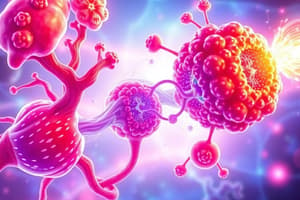Podcast
Questions and Answers
What is the primary function of the ATP synthase complex in the mitochondria?
What is the primary function of the ATP synthase complex in the mitochondria?
- Transporting electrons across the inner mitochondrial membrane
- Regulating the flow of protons back into the mitochondrial matrix
- Oxidizing NADH to produce more electrons
- Facilitating the conversion of ADP and Pi into ATP (correct)
Which component of the electron transport chain is NOT involved in the transfer of electrons?
Which component of the electron transport chain is NOT involved in the transfer of electrons?
- Complex III
- ATP synthase (correct)
- Complex II
- Complex I
How does the chemiosmotic theory explain the role of protons in ATP synthesis?
How does the chemiosmotic theory explain the role of protons in ATP synthesis?
- Protons are used to directly phosphorylate ADP into ATP
- Protons inhibit the reaction between ADP and Pi
- Protons create an electrochemical gradient that drives ATP synthesis (correct)
- Protons bind to ATP to generate energy for its synthesis
What role does NADH play in oxidative phosphorylation?
What role does NADH play in oxidative phosphorylation?
In the context of the electron transport chain, what is the role of oxygen?
In the context of the electron transport chain, what is the role of oxygen?
Which complexes in the electron transport chain act as proton pumps?
Which complexes in the electron transport chain act as proton pumps?
What is the role of the proton motive force in ATP synthesis?
What is the role of the proton motive force in ATP synthesis?
What happens to protons during oxidative phosphorylation?
What happens to protons during oxidative phosphorylation?
Which of these components is crucial for capturing free energy during catabolism?
Which of these components is crucial for capturing free energy during catabolism?
Why is the inner mitochondrial membrane impermeable to ions?
Why is the inner mitochondrial membrane impermeable to ions?
Flashcards are hidden until you start studying
Study Notes
Proton Gradient and ATP Synthesis
- Proton gradient across the inner mitochondrial membrane drives ATP synthesis via chemiosmotic theory.
- Complexes I and III translocate four protons each, while Complex IV translocates two protons into the intermembrane space.
- The accumulation of protons in the intermembrane space creates a proton motive force, with a negative electrochemical potential inside the matrix.
Role of the Respiratory Chain
- The respiratory chain, consisting of Complexes I, III, and IV, functions primarily as proton pumps, enhancing the proton gradient.
- This proton motive force is essential for the synthesis of ATP through ATP synthase as protons flow back into the mitochondrial matrix.
Energy Capture from Catabolism
- ADP captures high-energy phosphate during metabolic processes, representing the free energy released from catabolism.
- Two high-energy phosphate groups are generated from glycolysis, with an additional two from the citric acid cycle.
- Substrate-level phosphorylation occurs at key steps in both glycolysis and the citric acid cycle.
ATP Production from NADH
- For every mole of NADH oxidized via Complexes I, III, and IV in the respiratory chain, approximately 2.5 moles of ATP can be generated per 0.5 moles of O2 consumed.
- This results in a P:O ratio of 2.5, indicating the efficiency of ATP production linked to oxygen consumption.
Impact of Uncouplers
- Uncouplers increase membrane permeability to protons, disrupting the proton gradient by allowing protons to flow without going through ATP synthase.
- This uncouples electron transport from ATP synthesis, reducing energy capture efficiency during respiration.
Studying That Suits You
Use AI to generate personalized quizzes and flashcards to suit your learning preferences.





